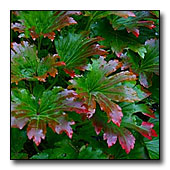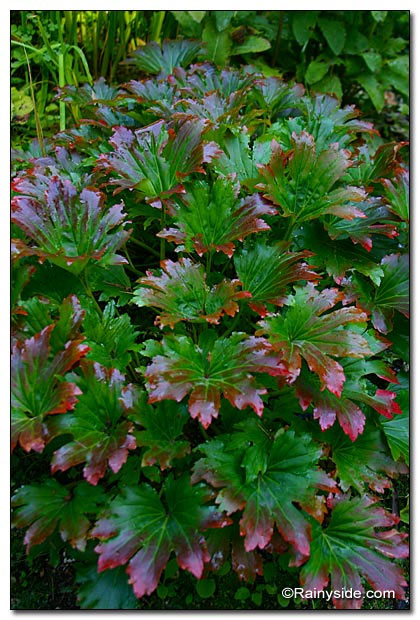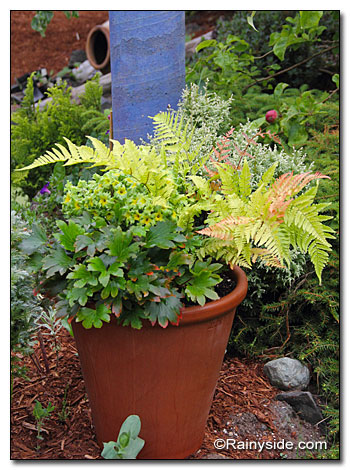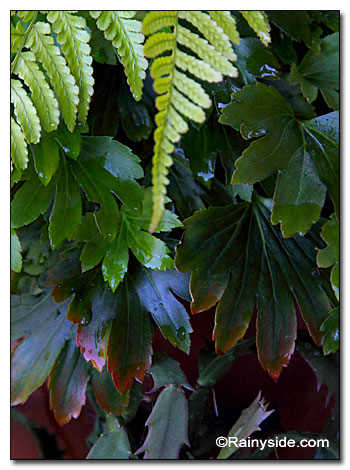Mukdenia rossii
syn. Aceriphyllum rossii
Family: Saxifragaceae
Pronounced: muk-DEE-nee-ah ROSS-ee-eye

Quick Jumps
Growing Guide
Rainy Side Notes
GROWING GUIDE

Origin:
Northeastern China, Korea.
Plant group:
Perennials.
Hardiness:
Sunset zones: Not listed.
USDA zones: 7-9.
Heat zones: 9-7.
Mature size:
Height: 14 inches (35 cm).
Width: 16 inches (40 cm).
Flowering period:
Spring.
Flowering attributes:
In May, cymes of white, star-shaped blossoms flower on top of erect stems.
Leaf attributes:
Buds unfurl to bronze-tinged, deeply lobed, maple-like, green foliage and has red to orange fall hues.
Growth habit:
Slowly spreading rhizomes.
Light:
Full sun to partial shade.
Soil:
Humus rich, moist, well-drained soil.
Feeding:
Side dress with leaf mold and/or compost.
Propagation methods:
Sow seeds in pots and place in coldframe in autumn.
Divide in spring.
Divide in late summer, placing divisions in containers. Plant out in garden once the rains return in fall.
Pruning methods:
N/A
Pests and Diseases:
Slugs and snails are a problem.
Rainy Side Notes

Mukdenia rossii growing in a container with
Dryopteris 'Brilliance' and Primula 'Green Lace'.

Mukdenia foliage in shade.
Foliage fans love this plant. As an ornamental gem from the saxifrage family, it is outstanding as a full sun to partial shade garden plant. Although the species has cymes of small, star-like, white flowers in spring, the deep-lobed foliage is the reason to grow it. At one time, its genus name was Aceriphyllum—a tribute to its bronze-tinged, maple-like leaves. When grown in ideal conditions, the foliage can grow up to eight inches in length. This luscious frondescence is held above the clumps of long stalks that rise up from their short creeping rhizomes that spread, albeit slowly. In autumn, it dazzles viewers with a display of red and orange before it slips underground for the cold season.
The genus, with only two species of perennials residing, was named after the Chinese city—once the capital of the Manchu Dynasty—Mukden. The plants thrive in our cool summers of the Pacific Northwest; however, they need an ample amount of water during our summer drought period.
In Japan, they commonly call these plants saw cranes and rock fatsia. Some cultivars coming out of Japan are M. ‘Karasuba’ which have leaves where the bronze to burgundy color is saturated around the lobes and leaf margins, keeping the hues well into autumn and turning a striking red. As with the species, the more sun you give the plant, the more intense the fall color.
Other Mukdenia cultivars include ‘Akaba’, ‘Maruba’,’ Ogon’, ‘Shishiba’, and a variegated variety named ‘Starstream’ (syn. ‘Variegata’).
Mukdenia ‘Crimson Fans’ similar to ‘Karasuba’ is said to have smaller leaves and shorter flower stems on compact plants, but some disagree and believe them to be the same plant. I will leave that to others to decide. Both are beautiful, and one or the other is a great addition to the foliage garden.
In Korea, the species, often used as an edible plant, is steamed and stir-fried. Exciting research showed that the roots of this species inhibit bacteria that cause tooth decay.
A Pacific Northwest Plant of the Week (2012)

Gardening for the Homebrewer: Grow and Process Plants for Making Beer, Wine, Gruit, Cider, Perry, and More
By co-authors Debbie Teashon (Rainy Side Gardeners) and Wendy Tweton
Copyright Notice | Home | Search | Perennials

